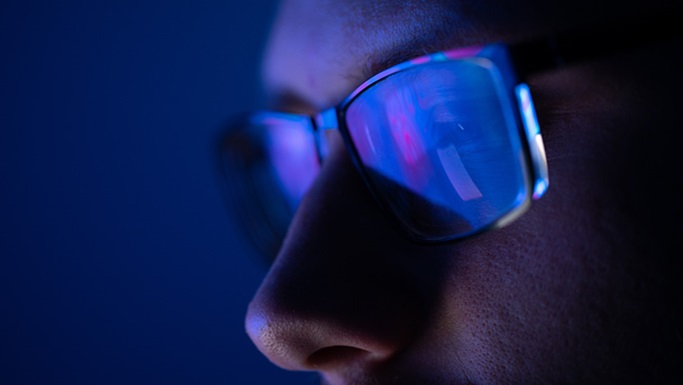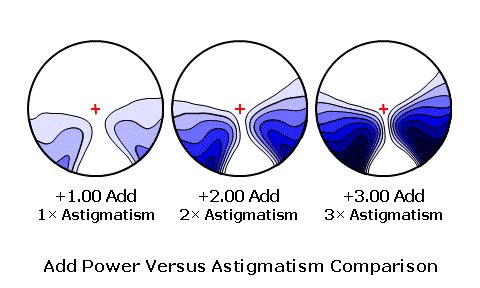People nearing the age of presbyopia have often told us that they heard about “horror” stories from those who are wearing progressive lenses and how they can’t get used to it. However there are also many people who has worn progressive lenses successfully. Our success rate for fitting progressive lenses is more than 95% .
There are a few reasons why some people have difficulty getting used to their progressive lenses, especially 1st time wearers.
- The lenses are not fitted correctly, ie they are not position properly in frame in relation the wearer’s needs.
- The spectacle frame does not stay in correct position when worn. This will result in wearer looking through the wrong part of the lens.
- The lenses are fitted wrongly and the prescription is inaccurate.
- 1st time wearer starts wearing progressive lenses at a later age when the amount of reading power required is very high. Higher reading power will have more distortion in the lens.
- 1st time wearers who have never worn glasses before.
- People wear progressive lens that are not intended for it’s use.
- People with low myopia who seldom wear their glasses when they do near work often would rather keep it that way.
- Some people are simply impatient and do not want to try wearing the progressive lens so that they can adapt to it.
Some people do not know how progressive lenses work and thought it can do everything for them. Because of this , some people get disappointed when the progressive lenses does not perform to their expectation.
At Evershine Optical, we try to find out as much as possible about your lifestyle and your needs and expectation before prescribing a pair of progressive lenses for you. Please do not be surprised if we ask you lots of questions when you just want to get a pair of glasses. This is a necessary step as we want to prescribe glasses or progressive lenses that are suited to your needs. For example, if you are an accountant and sits in front of the computer the whole day, if you are given a pair of general progressive lenses as compared to an office progressive lenses, you will be disappointed . There are also different progressive lenses that are suited to different lifestyle needs. If you have worn progressive lenses and are not satisfied, we would like to know the reasons too in order to find out if it’s the lens problem or the user problem .
Because of our approach to fitting progressive lenses or any lenses for that matter, we are able to achieve a high success rate and satisfaction for our customers. We always encourage our customers to come back if they have difficulty adapting to their lenses . Sometimes it’s a matter of explaining how progressive lenses work or what to expect or the spectacle needs some minor adjustment. We will try to find a solution regardless of the problem you are facing with your new lenses.
Below is an excerpt from Zeiss Vision care regarding the wearing of progressive lenses.
First-time progressive lens wearers may take a little time to get used to them
But don’t worry: The rate of success for modern progressive lenses is nowadays extremely high. Nevertheless, it is important that the wearer takes time to get used to their new progressive lenses.
The eye and the brain have to learn to adjust to the different refractive powers of the lenses. Here is an example: When someone wearing progressive lenses climbs stairs, they will look through the lower portion of their lenses. In progressive lenses, this is the area that is adjusted for a reading distance of approximately 40 centimetres. The stairs are, of course, depending on their size, clearly further away. Thus the stairs will be viewed with distortion.
The good news: The sense of sight is highly complex – and it is also a very adaptable system. Within a short period of time, it is able to learn and to adapt to new viewing conditions; so when climbing the stairs, a wearer simply points his head somewhat further downwards.
What will I experience when getting used to wearing progressive lenses?
- Areas of soft focus at the edges of the lenses.
- More head movement – and less moving of the pupils, especially for near distances, since the field of view for near-distances is located in the lower part of the lenses.
- On the whole you have to get used to the individual areas of vision and their position in the spectacles: in the lower area you will see short viewing distances clearly. If you look in the distance, you will have to do this using the upper portion of the lens to obtain clear vision.
All of this is completely natural, and will diminish within a short period of time – as you quickly adapt to your progressive lenses. However, more importantly: You should wear your new progressive lenses daily from the very beginning – from morning until evening. And age makes no difference, though the earlier you start wearing them, the easier it is to get used to them.
Can I adapt to my progressive lenses ?
How much change can humans adapt?
A study looked into the ability to adjust to new viewing conditions. This experiment tested the absolute limits the human visual system could adapt. The study paid college students to wear special glasses every waking moment of the day. The students were told to put the glasses on from the first moment they awakened to when they went to bed. They were to do everything with them on even shower and bathe with them on.
One half of the glasses were a simple lens with no prescription in it for a control. The experimental half had glasses that turned the world upside down. Up was Down and Left was Right. The experimental group had a terrible time. Imagine trying to navigate the world that’s upside down. Walking was awkward and unsteady with poor balance.
Subjects developed headaches, eyestrain even nausea and vertigo. Their handwriting was awful. They had trouble reading, eating, typing and moving around. These symptoms lasted about 3 weeks. Then remarkabily they all adapted. In the second half of the experiment the glasses were taken away and the symptoms came back while adjusting back to the normal world. Their recovery was much shorter – 3 days instead of 3 weeks.
This experiment showed that with extreme prescriptions, adaptation is possible. It also showed that a motivated individual will work at keeping their glasses on to allow adaptation. In the experiment, college age students were being paid to participate. They had a motivation to succeed to earn the money.
In the real world
In the real world, we can’t expect people to change to this dramatic amount. Fortunately no eyewear prescription is ever this disruptive. We can ask that they try to give it 3 weeks of real committed effort.
Another factor involves age. Subjects age 20 will adapt more easily than subjects age 30 and age 30 subjects will adapt more easily than age 40 and so on. Neurological adaptation slows over the decades.
A 70 year old with real vision problems caused by a retina disease will be a real challenge. There will never be an instant fix in acclimatizing with glasses. Their expectations are based on previous glasses instantly sharpening vision and feel disappointed when this is not achieved. Or the glasses may swim and swirl around because somehow they are “too strong” or “too weak” or “not right.”
Even folks age 40 can have trouble adjusting to their first progressive lens. The same observations have been reported in people getting used to a no line bifocal.
This effect is more common if a history of motion sickness or a condition like Meniere’s disease exists. Some correlations with fibromyalgia have been correlated as well with success with Rx changes but this relationship needs further research.
source : http://guthrieeyecare.com/icare/why-do-glasses-fail/


